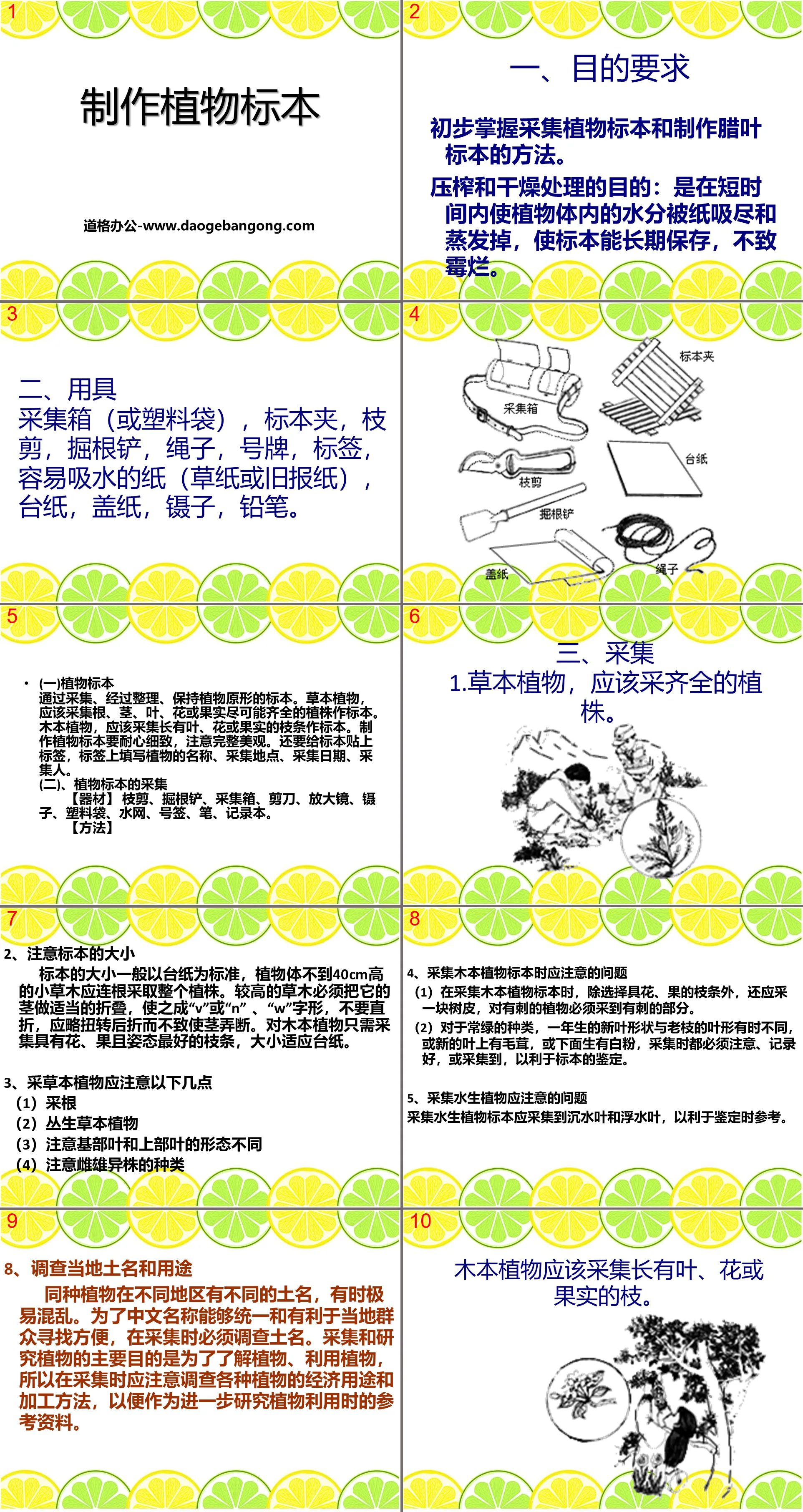Fifth Grade Science Volume 1, Textbook Edition
Science Edition for Sixth Grade Science Volume 2
Science Edition for Sixth Grade Science Volume 1
Third Grade Science Volume 2, Textbook Edition
Third Grade Science Volume 1, Textbook Edition
Fourth Grade Science Volume 2, Textbook Edition
Fourth Grade Science Volume 1, Textbook Edition
Qingdao Edition Fourth Grade Science Volume 2
Fourth-grade science volume 2 of the E-education edition
Hunan Education Edition Fourth Grade Science Volume 1
E-education edition fifth grade science volume 2
Fifth Grade Science Volume 2, Textbook Edition
E-education edition fifth grade science volume 1
Qingdao Edition Fifth Grade Science Volume 2
Hunan Education Edition Fifth Grade Science Volume 2
E-education edition sixth grade science volume 1

| Category | Format | Size |
|---|---|---|
| People's Education Press Fourth Grade Science Volume 1 | pptx | 6 MB |
Description
"Making Plant Specimens" Learn more about biology PPT courseware
1. Purpose requirements
Preliminarily master the methods of collecting plant specimens and preparing wax leaf specimens.
The purpose of pressing and drying is to absorb and evaporate the water in the plant body by the paper in a short period of time, so that the specimen can be preserved for a long time without causing mold and rot.
2. Utensils
Collection box (or plastic bag), specimen clips, pruning shears, root digging shovel, rope, number plate, label, absorbent paper (straw paper or old newspaper), table paper, cover paper, tweezers, pencil.
(1) Plant specimens
By collecting, sorting and maintaining plant specimens in their original form. For herbaceous plants, plants with as complete roots, stems, leaves, flowers or fruits as possible should be collected as specimens. For woody plants, branches with leaves, flowers or fruits should be collected as specimens. When making plant specimens, you need to be patient and meticulous, paying attention to their completeness and beauty. The specimens must also be labeled, and the name of the plant, collection location, collection date, and collector must be filled in on the label.
(2) Collection of plant specimens
[Equipment] Branch shears, root shovel, collection box, scissors, magnifying glass, tweezers, plastic bag, water net, number tag, pen, record book.
【method】
3. Collection
1. Herbs should be collected from complete plants.
2. Pay attention to the size of the specimen
The size of the specimen is generally based on table paper. For small plants with a height of less than 40cm, the entire plant should be taken from the root. The stems of taller plants must be folded appropriately to form a "V" or "N" or "W" shape. Do not fold them straight, but twist them slightly and fold them to avoid breaking the stems. For woody plants, only the branches with flowers and fruits that have the best appearance should be collected, and the size should be suitable for the table paper.
3. When picking herbs, you should pay attention to the following points:
(1) Picking roots
(2) Clustered herbaceous plants
(3) Pay attention to the different shapes of the basal leaves and upper leaves
(4) Pay attention to dioecious species
4. Issues that should be paid attention to when collecting woody plant specimens
(1) When collecting woody plant specimens, in addition to selecting branches with flowers and fruits, a piece of bark should also be collected. For thorny plants, the thorny part must be collected.
(2) For evergreen species, the shape of new annual leaves is sometimes different from that of old branches, or there may be hairs on the new leaves, or white powder on the undersides. This must be noted and recorded when collecting, or the , to facilitate specimen identification.
5. Issues that should be paid attention to when collecting aquatic plants
When collecting aquatic plant specimens, submerged leaves and floating leaves should be collected for reference during identification.
4. Preparation of wax leaf specimens (issues that need attention)
(1) Fold or trim the specimen to the corresponding size of the table paper (about 30 cm in length and 25 cm in width)
(2) Expand the branches and leaves, fold and lay out a small branch or part of the leaves, and you can see the structure of both sides of the plant during observation and identification. Adjust the branches, leaves, flowers and fruits that are too dense on the plant body (but keep the petioles to indicate the way and position of the leaves, and be careful not to overlap the flowers and fruits).
(3) Stems or twigs should be cut diagonally to observe the hollow or pith-containing internal structure.
(4) The large leaves can be cut off from one side of the main vein and folded, or can be cut into several parts.
(5) Herbs can be folded into V-shape, N-shape, or W-shape. If there is too much soil at the roots, it should be cleaned up before pressing.
Method 1. Preparation of general wax leaf specimens
(Take rabbit's foot fern specimen preparation as an example)
Collect, sort, press, change paper, disinfect, and put paper on stage
1. Material selection
1. Rabbit's foot fern is a fern with hard leaves that are not easy to shrink when pressed.
2. Plant characteristics: The roots have many lateral roots, the stems have scales and hairs on the surface, and the leaves are green.
3. Appropriate size, complete shape, free of diseases and insect pests.
2. Equipment: specimen clips, scissors, root digging shovel, table paper, absorbent paper, collection box, sewing box, glue.
3. Collection of specimens: Dig out the plants with a root shovel to ensure the integrity of the plants.
4. Preparation and suppression of specimens:
1. Rinse the plants under tap water and place them in a ventilated place to dry naturally or use absorbent paper to dry them (avoid direct sunlight causing wilting of the plants).
2. Lay the specimen clamp with a rope flat as a base, and lay 5 layers of absorbent paper on top.
3. Place the dried plants flat on the absorbent paper, flatten and shape them so that the plants are in a natural state and avoid covering each other (put the back of a leaf facing up for comparison and observation).
4. Cover the arranged plants with 3 layers of absorbent paper. Each time a specimen is placed, cover it with 3 layers of paper, about 10 copies. When the last specimen is placed, cover it with 5 layers of paper, and then press the other fan of the specimen folder. , press it as tightly as possible, tie it firmly with a rope, and place it in a ventilated place to suppress it.
Method 2. Preparation of original color wax leaf specimens
1. Preparation: Grind silica gel into powder, pass through a fine sieve, dry at 100°C or above, and store in an airtight container. Some absorbent paper, 4 sheets in a stack, set aside.
2. Pressing: Put 2 stacks of paper on the bottom plate of the specimen clip, sprinkle a layer of silica gel powder, put a stack of paper on top, put the specimen on the paper, and then put another stack of paper, place them layer by layer, and tie up the specimen clip.
3. Baking: 40-50℃, take out after 2 hours. Replace the water-draining paper and silica gel. Do this 4-5 times in a row until the specimen is dry.
4. Disinfect and put on paper, the same as ordinary wax leaf specimens.
Method 3. Preparation of leaf vein specimens
1. Separation: Boil with 10-20% NaOH solution for 20-30 minutes, then wash with water. Use a brush in water to remove the leaf epidermis and mesophyll tissue.
2. Bleaching: Soak in 10% H2O2 solution for 8-12 hours.
3. Dyeing: Dip dye with 10% magenta, magenta green, etc. for a few minutes.
4. Cleaning: Rinse with 5% dilute hydrochloric acid and water.
5. Pressing, disinfecting and staging paper are the same as ordinary wax leaf specimens.
Notice:
①Selection of materials: vigorously growing leaves.
②The concentration of corrosive liquid: slightly higher for woody plants.
③ During the corrosion process, it should be taken out from time to time and placed in a low-alkali solution and brushed with a brush.
④ When corroded, the petiole is exposed to the liquid surface.
Keywords: Understand more biology teaching courseware, make plant specimen teaching courseware, download PPT courseware for fourth grade science from the People's Education Edition, download science slide courseware for fourth grade, download more biology PPT courseware, make plant specimen PPT courseware Download, .PPT format;
For more information about the PPT courseware "Understanding More Organisms and Making Herbarium Specimens", please click the "Understanding More Organisms and Making Herbarium Specimens" ppt tag.
"Making Plant Specimens" Learn more about biology PPT courseware 2:
"Making Plant Specimens" Learn more about biology PPT courseware 2 Teaching purpose: Be familiar with every step of making plant specimens. Master the basic skills of making plant specimens. Complete specimen making independently without guidance. How much do you know about making plant specimens? 1. You...
File Info
Update Time: 2024-09-24
This template belongs to science courseware People's Education Press Fourth Grade Science Volume 1 industry PPT template
"Making Plant Specimens" Learn more about biology PPT courseware Simple campus recruitment activity planning plan summary enterprise and institution recruitment publicity lecture PPT template is a general PPT template for business post competition provided by the manuscript PPT, simple campus recruitment activity planning plan summary enterprise and institution recruitment promotion Lecture PPT template, you can edit and modify the text and pictures in the source file by downloading the source file. If you want more exquisite business PPT templates, you can come to grid resource. Doug resource PPT, massive PPT template slide material download, we only make high-quality PPT templates!
Tips: If you open the template and feel that it is not suitable for all your needs, you can search for related content "Making Plant Specimens" Learn more about biology PPT courseware is enough.
How to use the Windows system template
Directly decompress the file and use it with office or wps
How to use the Mac system template
Directly decompress the file and use it Office or wps can be used
Related reading
For more detailed PPT-related tutorials and font tutorials, you can view: Click to see
How to create a high-quality technological sense PPT? 4 ways to share the bottom of the box
Notice
Do not download in WeChat, Zhihu, QQ, built-in browsers, please use mobile browsers to download! If you are a mobile phone user, please download it on your computer!
1. The manuscript PPT is only for study and reference, please delete it 24 hours after downloading.
2. If the resource involves your legitimate rights and interests, delete it immediately.
3. Contact information: service@daogebangong.com
"Making Plant Specimens" Learn more about biology PPT courseware, due to usage restrictions, it is only for personal study and reference use. For commercial use, please go to the relevant official website for authorization.
(Personal non-commercial use refers to the use of this font to complete the display of personal works, including but not limited to the design of personal papers, resumes, etc.)
Preview










